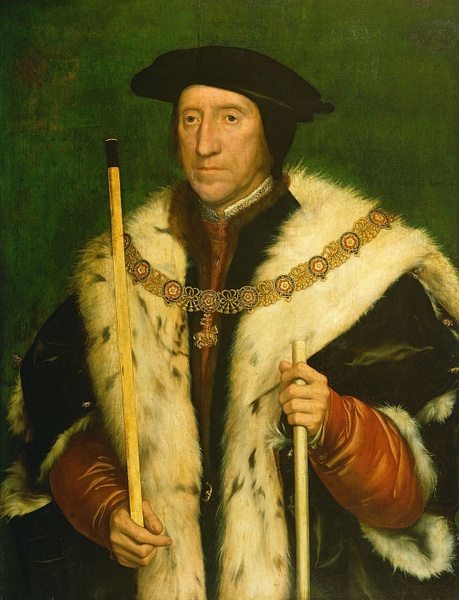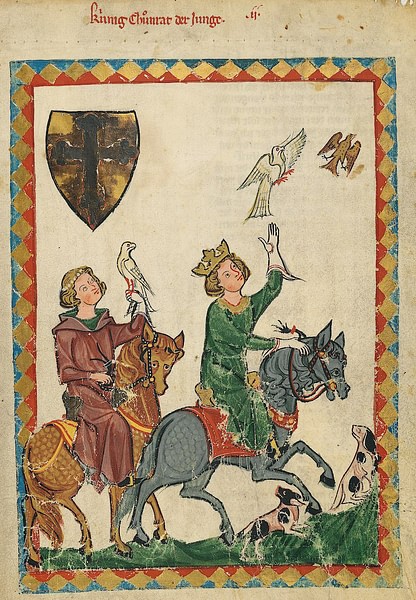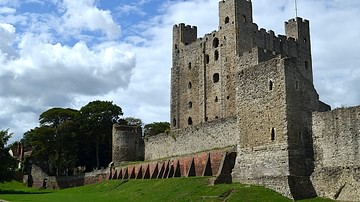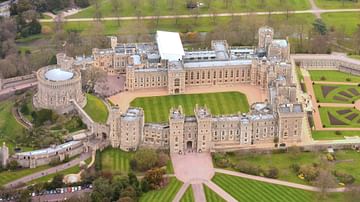An English medieval castle, if a large one, could have a household staff of at least 50 people, which included all manner of specialised and skilled workers such as cooks, grooms, carpenters, masons, falconers, and musicians, as well as a compliment of knights, bowmen, and crossbow operators. Most staff were paid by the day, and job security was often precarious, especially for the lowest servants who were dismissed when a castle lord travelled away from the castle. More skilled workers such as the castle chaplain, the steward or general manager, and the marshal, who supervised the men-at-arms and stables, were paid by the year and might receive money and land in return for loyal service. A microcosm of the medieval world, the household staff worked as a team to meet the castle's often extensive needs of nourishment, defence, and entertainment.

Knights & Soldiers
The staff of a castle may be divided into two broad groups: men-at-arms and domestic servants. The former, sometimes known as the mesnie personnel, were led by the marshal and made responsible for the castle's defence. They might also take part in attacks outside the castle grounds, perform bodyguard duties for the local lord and generally patrol the lord's lands as a reminder of the necessity for peasants to comply with regulations, calls for taxes, pay fines and so on.
The knights of a castle might be permanently stationed there, and so their pay was met by the castle's lord. Another possibility was that local barons had to supply knights to a particular castle for a fixed term of service, especially those important for national defence like Dover Castle. Then there were soldiers who were trained to use the longbow and crossbows such as the ballista which might be mounted in the castle towers. Other men-at-arms acted as guards for the gate and as watchmen. Squires or trainee knights would have learnt their business at the castle, which might have a training area for jousting and swordsmanship.
The Steward
The lady of the castle was in charge of its daily management and supplies, but naturally, the mundane task of procurement, logistics, and staff management was usually in the hands of the castle steward or seneschal. The domestic staff of a large castle could easily exceed 50 people, so the role was not an easy one. The steward was also responsible for all financial and legal matters concerning the castle's estates. Such was the importance of the role and the weight of a steward's duties that by the 13th century CE a large castle might have two of them, one for the internal affairs of the castle and one for its estates. The latter steward was usually a knight, and he oversaw the local court (hallmote or halimote) which ensured that the law was applied in all local cases except serious crimes such as murder. The steward did not act as judge, a role fulfilled by a jury or body of suitors (local men of rank), but his presence gave weight to the final decision.
The steward supervised any inner advisory circle of nobles the lord might have and sometimes represented the lord further afield such as at the royal court. If a lord were absent from his castle for any length of time such as during a war, the steward might take charge of the castle entirely. In the case of royal castles where the king was not, and could not be, present at all times, then a constable, who might also be the local sheriff, ran the castle in the sovereign's name.

As the steward represented the lord of the castle, then, it is perhaps not surprising that he looked the part and often wore fine robes with fur trim. Well-paid and sometimes given his own property near the castle, the steward kept a close record of the estate accounts and the regular income from tenants, taxes and fines paid to the castle's law courts.
The aristocracy of medieval England read handbooks on anything from table manners to falconry, and so there were, too, helpful guides on how to choose and manage one's castle staff, including the steward. The following extract is from one such manual titled Stewardship (Seneschaucie):
The seneschal of lands ought to be prudent and faithful and profitable, and he ought to know the law of the realm, to protect his lord's business and to instruct and give assurance to the bailiffs who are beneath him in their difficulties. He ought two or three times a year to make his rounds and visit the manors of his stewardship, and then he ought to inquire about the rents, services and customs…and about franchises of courts, lands, woods, meadows, pastures, waters, mills, and other things which belong to the manor… (Gies, 97-8)
Such were the demands of the steward's job that by the 13th century CE there were even training colleges for them such as the one at Oxford. There, following a course of 6 to 12 months, they could acquire the necessary skills in accounting, letter writing, and knowledge of the law.
The Marshal
A castle always had stables as horses were essential for the knights, communication via messengers, hunting parties, and any general travel needs. Carts with two or four wheels were needed to transport supplies to and from the castle and came under the jurisdiction of the marshal who was in overall charge of the stables as well as the fighting force garrisoned at the castle if there was one. To assist the marshal in his duties of keeping track of everything, there would have been a number of clerks. Here, too in the courtyard buildings, was the blacksmith and carpenter who could repair the carts and anything else in the castle. The blacksmith made such necessities as horseshoes and sharpened knives, sheers and other agricultural tools, while the carpenter might be called on to make furniture and erect small buildings inside the castle. There might also be a master mason for repairs to the castle's stonework.
The grooms of a castle swept out the stables and had to look after not only the castles own horses but also those of guests and their retainers, who could be frequent and numerous. Ranked between the level of the grooms and the men-at-arms were the messengers who delivered letters, receipts, and goods across the castle's estates and beyond. Although a messenger received certain perks like special robes and a free pair of shoes each year, there were also hazards such as being made to eat the letter, seals and all, they had delivered to a displeased recipient and even being beaten and imprisoned.
As hunting and falconry were hugely popular pastimes a castle might maintain its own pack of hunting dogs and a number of falcons. Huntsmen, falconers, and dog-handlers looked after these animals whose training could take years. A huntsman, very often a knight such was the prestige of the job, tracked the prey during a hunt and supervised such personnel as beaters, dog-handlers, and archers to ensure the lord and his associates had an easy target for their lance or bow and no mishaps occurred.
The Chaplain
Most castles had their own chapel and a permanent chaplain for the private use of the lord and his family. In a large castle, the chaplain was known as the chancellor. He presided over daily religious services but, thanks to his education in Latin or French, had other important duties besides ecclesiastical matters such as writing the business and personal correspondence of the castle's lord and using his seal. The chaplain had his own clerks which made up the castle's secretarial department, and he frequently travelled when the lord did, taking with him a portable altar. Another member of the chaplain's staff was the almoner who gave out daily alms to the poor, particularly dinner leftovers and any unwanted clothes. Finally, the chaplain was usually responsible for the education of the noble children in the castle.
Chamberlains, Laundresses & Personal Attendants
A chamberlain looked after the lord's own chamber and the wardrobes of the castle, including the liveries of the knights which usually carried the lord's coat of arms or badge. Some castles had a separate person, the keeper of the wardrobe, in charge of clothing, which was usually kept in wooden chests. The chamberlain might also be responsible for the Great Hall while the usher controlled who came in and out of it. The chamberlain's primary concern was the lord himself, though, and his general comfort. Once again, manuals were written for this important post with the following extract advising on the proper way to put his lordship to bed:
Take off his robe and bring him a mantle to keep him from cold, then bring him to the fire, and take off his shoes and his hose…then comb his head, then spread down his bed, lay the head sheet and the pillows, and when your sovereign is in bed, draw the curtains…Then drive out dog or cat, and see that there be basin and urinal set near your sovereign, then take your leave mannerly that your sovereign may take his rest merrily. (Gies, 123-4)
A castle had a laundress and her team of underlings who were responsible for ensuring all clothes, sheets, towels, and tablecloths were as clean as they should be. These items were washed in a wooden trough containing wood ashes and caustic soda and pounded. Extra duties might include washing the lady of the castle's hair.
There were chambermaids to tidy up and make rooms ready, prepare the fires, and empty the chamberpots, and in larger castles, a resident barber, doctor, and dentist. Most domestic servants would have slept in shared chambers in either the cellars or attics of the castle buildings. There might also be simple buildings outside the castle for herdsmen, mill workers, wood-cutters, and craftspeople such as rope-makers, candle-makers, potters, basket-weavers, and spinners. These people would have worked and lived in such external buildings and withdrawn to the castle only if it came under attack.
The Kitchens
The cook was in charge of the kitchens and food preparation in the castle and was assisted by a team of undercooks, servers, and cupbearers. Youngsters would have had the menial tasks of washing, fetching and carrying, and turning the meat on a spit while it roasted, the 'spit-boys'. There was also the butler and his alcoholic drinks store in the buttery, the pantler in charge of the pantry with its supply of bread, the baker, and all kinds of specialists depending on the size of the castle such as a sauce chef, a dessert chef, a wafer maker, a brewer, a slaughterer, a poulterer, and a fruiterer. There were even members of staff responsible for specific aspects of the medieval dining experience like the tablecloths, the candles, and the silver dining service.
Entertainers
There were many kinds of professional entertainers in medieval England such as troubadours, actors, acrobats, and jesters, who toured and sought their living where they could. Minstrels (jongleurs), on the other hand, were in the permanent employ of the castle. They sang and played the lute, recorder, shawm (an early version of the oboe), vielle (an early violin), and percussion instruments such as drums and bells. They performed chanson de gestes and chansons d'amour, epic poems in Old French which told familiar stories of knightly daring deeds and impossible romances respectively.
HONORARY DOMESTIC ROLES
Many domestic roles inside a castle changed over time, of course, and some senior ones became an entirely honorary title with little practical connection to their original function. In the royal court, the position of steward, chancellor (chaplain), chamberlain and marshal all acquired much wider significance and were positions of real power. The chamberlain had control of the royal purse and the marshal was put in charge of the army. Even simple tasks at court such as arranging a banquet or bearing the king's cup at dinner became a great privilege and sign of rank, sometimes even a hereditary one.







